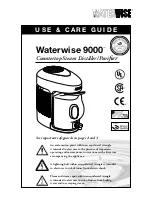
Low-pressure limit switch
The low-pressure limit switch is not monitored during the initial 30 seconds of compressor
operation. After the initial 30 seconds have passed, the microprocessor control will monitor the low-
pressure switch for another 30 seconds. If the low-pressure switch fails to close after the 30 second
monitoring phase, the microprocessor control will de-energize the compressor, initiate the ASCD,
and stop the fan.
Once the low-pressure switch has been proven (closed during the 30-second monitoring period
as described above), the microprocessor control board will continue to monitor the low-pressure
limit switch for any openings. If the low-pressure switch opens for greater than 5 seconds, the
microprocessor control board will de-energize the compressor, initiate the ASCD, and stop the fan.
If the call for cooling is still present at the conclusion of the ASCD, the microprocessor control will
re-energize the compressor.
Should a low-pressure switch fault three times within one hour of operation, the microprocessor
control board will lock-out the compressor and flash a fault code indicating a low-pressure lock-out.
Condensate overflow switch
A Condensate Overflow fault occurs when the condensate overflow switch opens for more than
two line cycles. The compressor is shut down regardless of Minimum Run Time, ASCD is initiated,
and alarm is tripped. The fan continues operating in its current state. Compressor will re-energize
once the condensate overflow switch closes, ASCD has been satisfied, and a call for cooling is still
present.
The microprocessor control board logs the first incident per compressor request. If the compressor
request is removed, the fault occurrence counter is reset to zero. Should the condensate overflow
switch open 3 times within 1 hour of run time, the microprocessor control board will lock out the
compressor, turn off the fan, and flash a fault code indicating a Condensate Overflow lockout.
The condensate overflow switch is a normal close switch. For the condensate overflow switch
shown in Figure 39 in the normal situation, the coil of the relay R3 is energized, two of the normal
open contacts in R3 are closed, the two lines on both FS1 and FS2 are connected similar to a jumper,
and the two compressors run based on the other condition. Upon the Condensate Overflow fault
occurring, the normally closed contacts in this switch will become open, it will cut off the line of the
circuit, the two lines on both FS1 and FS2 will disconnect, and the two compressors will shut down.
Safety controls
The microprocessor control monitors the following inputs:
1. A High-Pressure Switch on each compressor circuit to protect against excessive discharge
pressures.
2. A Low-Pressure Switch on each compressor circuit to protect against loss of refrigerant
charge.
3. A Condensate Overflow Switch to protect against condensate overflow.
Compressor protection
In addition to the external pressure switches, the compressor also has inherent (internal)
protection. If there is an abnormal temperature rise in a compressor, the internal protection
will immediately shut down the compressor. The microprocessor control incorporates features
to minimize compressor wear and damage. An ASCD is utilized to prevent short cycling of the
compressor. Additionally, a minimum run time is imposed any time a compressor is energized. The
ASCD is initiated on unit start-up and on any compressor reset or lockout.
C-Series Vertical (CSV) Water-Cooled Self-Contained Units, B Generation, R-410A Installation, Operation, and
Maintenance Manual
66





































